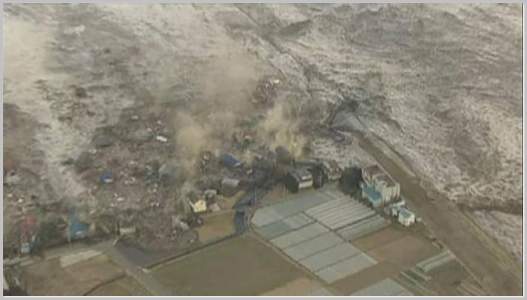
Earthquakes and tsunamis are closely related. All tsunamis are caused by massive deep-level water displacement, which is most common during subduction and megathrust earthquakes under the ocean floor. A tsunami cannot result from a land-based earthquake unless it causes a landslide into a nearby body of water.
How it works
When an earthquake shifts part of the ground beneath the ocean, a large volume of water is displaced. The sudden displacement releases vast amounts of energy into the ocean. In general, the greater the physical displacement of the sea floor, the greater the amount of energy which is released into the water.
All this energy is converted into wave energy, which is carried across the ocean. Unlike typical surface waves and even storm surges, this wave energy is carried by the motion of the entire water column from the top of the ocean to its bottom. The vast amount of water involved also causes the tsunami to have an unusually long wavelength, with a width of several miles. As soon as the ocean floor becomes shallow, all that volume of water is forced upward. If enough energy has been released by the initial displacement of the sea floor, a tsunami will result.
However, the vast majority of undersea earthquakes do not produce tsunamis. Even strong earthquakes may not produce tsunamis if they occur too far underground. Statistics from the China Earthquake Administration show that, from over 15,000 recent undersea earthquakes, only 100 produced tsunamis.
A tsunami usually requires an earthquake of at least Richter magnitude 6.5 or higher, although tsunami warnings will sometimes be issued for a smaller offshore earthquake where the local geological conditions increase the hazard. Both the 2004 Indian Ocean tsunami and the 2011 Tohaku tsunami were caused by subduction earthquakes which were Richter magnitude 9 or higher.
The direction of the sea floor fault will determine the direction of the tsunami wave. This is critically important for knowing which areas are in danger. During the 2004 Indian Ocean tsunami, parts of Sumatra and East Africa were hit by the tsunami. However, Bangladesh was well to the north of the fault and out of the path of the tsunami, while Singapore was sheltered by Sumatra and was completely untouched.
Tsunamis without earthquakes?
A tsunami may be caused by an earthquake which was too deep or too far away to be felt by anything other than seismographs. These powerful waves can travel for thousands of miles without losing much energy. Most regions are at greatest risk from tsunamis which are generated locally only because very little warning is possible in these cases.
However, not all tsunamis are caused by earthquakes. Tsunamis can be caused by mountain-sized landslides or the calving of glaciers into the ocean, sea or lake-sized body of water. They can also be caused by volcanoes or even meteor strikes.
All these causes share two important factors: the water must be displaced suddenly, and the resulting wave energy must be forced upward by an upward-sloping sea floor or a narrowing channel. If the wave energy is forced in any other direction, it will eventually dissipate without causing a tsunami.

